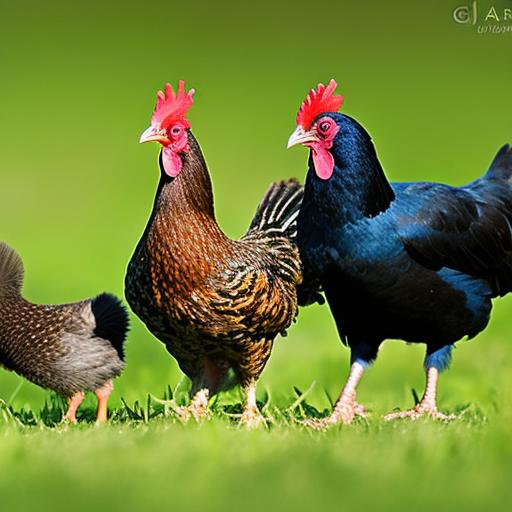Keeping chickens with grass is a popular and rewarding method of raising poultry. It involves allowing chickens to roam freely on grassy areas, providing them with a natural and nutritious diet. This method has gained popularity in recent years due to its numerous benefits for both the chickens and the chicken keepers. In this article, we will explore the benefits of keeping chickens with grass, discuss the nutritional needs of chickens, provide tips on choosing the right grass for your flock, and offer advice on maintaining a healthy grass environment for your chickens.
Key Takeaways
- Keeping chickens with grass has many benefits, including providing a natural environment for the birds and improving soil health.
- Chickens have specific nutritional needs that can be met by allowing them to forage on grass and other plants.
- Choosing the right type of grass for your chickens depends on factors such as climate, soil type, and the size of your flock.
- Preparing your yard for chickens involves creating a safe and secure space for them to roam and providing access to fresh water and food.
- Building a chicken coop on grass requires careful planning to ensure that the birds have enough space and protection from predators.
The Benefits of Keeping Chickens with Grass
Keeping chickens with grass offers several benefits that make it an attractive option for chicken keepers. One of the main benefits is improved nutrition for the chickens. Grass is a natural source of vitamins, minerals, and other essential nutrients that are beneficial for the overall health and well-being of chickens. When chickens have access to fresh grass, they can supplement their diet with these nutrients, resulting in healthier and more productive birds.
Another benefit of keeping chickens with grass is reduced feed costs. Grass is abundant and readily available, making it a cost-effective alternative to commercial chicken feed. By allowing your chickens to graze on grass, you can significantly reduce your feed expenses while still providing them with a nutritious diet.
Personal experiences and anecdotes can make this post more relatable. For example, many chicken keepers have reported that their chickens have healthier feathers and brighter egg yolks when they have access to grass. Some have even noticed an increase in egg production after introducing grass into their chickens’ diet.
Understanding the Nutritional Needs of Chickens
To understand why keeping chickens with grass is beneficial, it’s important to understand the nutritional needs of chickens. Chickens require a balanced diet that includes protein, carbohydrates, fats, vitamins, and minerals. These nutrients are essential for growth, egg production, and overall health.
Grass can help meet these nutritional needs in several ways. Firstly, grass is a good source of protein, which is crucial for muscle development and egg production in chickens. It contains amino acids that are necessary for the synthesis of proteins in the body.
Secondly, grass is rich in vitamins and minerals that are essential for the health and well-being of chickens. For example, grass contains vitamin A, which is important for vision and immune function. It also contains calcium, phosphorus, and magnesium, which are necessary for strong bones and eggshell formation.
Choosing the Right Grass for Your Chickens
When it comes to choosing the right grass for your chickens, there are several factors to consider. Different types of grass have different nutritional profiles and growth habits, so it’s important to choose one that suits your chickens’ needs and preferences.
One popular choice for chicken keepers is Kentucky bluegrass. This grass is known for its high protein content and palatability, making it an excellent choice for chickens. Other suitable grasses include perennial ryegrass, tall fescue, and Bermuda grass.
When choosing grass for your chickens, consider factors such as climate, soil type, and maintenance requirements. Some grasses thrive in cooler climates, while others are better suited to warmer regions. Additionally, some grasses require more water and maintenance than others.
Preparing Your Yard for Chickens
Before introducing chickens to your yard, it’s important to prepare the area to ensure their safety and well-being. Start by removing any toxic plants or substances that could harm your chickens. Some common plants that are toxic to chickens include azaleas, rhododendrons, and oleander.
Next, create a safe environment for your chickens by installing fencing around the perimeter of your yard. This will prevent predators from entering the area and keep your chickens safe from harm. Make sure the fencing is secure and tall enough to prevent predators from jumping over or digging under.
To make your yard more attractive to chickens, consider adding features such as perches, dust baths, and nesting boxes. These additions will provide your chickens with opportunities for exercise, relaxation, and egg-laying.
Building a Chicken Coop on Grass

Building a chicken coop on grass offers several benefits for both the chickens and the chicken keepers. One of the main benefits is that it allows the chickens to have direct access to fresh grass, which is essential for their health and well-being. Additionally, building a coop on grass can help reduce the risk of parasites and diseases that can be found in soil.
When building a chicken coop on grass, it’s important to choose the right materials and design. The coop should be sturdy, secure, and well-ventilated to provide a safe and comfortable environment for the chickens. Consider using materials such as wood or metal for the frame and wire mesh for the walls and roof.
Design considerations include the size of the coop, the number of nesting boxes and perches, and the placement of doors and windows. Make sure the coop is large enough to accommodate your flock comfortably and provides enough space for them to move around freely.
Maintaining a Healthy Grass Environment for Chickens
Maintaining a healthy grass environment is essential for the well-being of your chickens. Regular mowing is important to keep the grass at an optimal height for grazing. Aim to keep the grass between 2-4 inches tall, as this will provide a good balance between nutrition and palatability.
Fertilization is another important aspect of maintaining a healthy grass environment. Use organic fertilizers that are safe for chickens and avoid using chemical-based products that could harm them. Additionally, consider using natural pest control methods to keep pests such as insects and worms under control.
Regularly inspect your grass for signs of disease or damage. If you notice any issues, take appropriate measures to address them and prevent further damage. This may include applying fungicides or herbicides, or making changes to your chickens’ diet or environment.
Common Challenges of Keeping Chickens with Grass
While keeping chickens with grass offers numerous benefits, it also comes with its fair share of challenges. One common challenge is the presence of predators such as foxes, raccoons, and hawks. These predators can pose a threat to your chickens and their eggs, so it’s important to take measures to protect them. This may include installing predator-proof fencing, using motion-activated lights or alarms, or providing shelter for your chickens to retreat to.
Another challenge is the risk of parasites and diseases that can be found in grass. Chickens are susceptible to a variety of parasites, including mites, lice, and worms. Regularly inspect your chickens for signs of infestation and take appropriate measures to treat and prevent these issues. This may include using natural remedies or consulting a veterinarian for advice.
Tips for Keeping Your Chickens Safe on Grass
To keep your chickens safe on grass, there are several tips you can follow. Firstly, provide adequate shelter for your chickens to protect them from predators and adverse weather conditions. This can be in the form of a coop or a covered run where they can seek refuge when needed.
Secondly, use fencing to create a secure area for your chickens to roam freely. Make sure the fencing is tall enough to prevent predators from jumping over and bury it deep enough to prevent them from digging under.
Lastly, regularly inspect your chickens for signs of illness or injury. Early detection is key in preventing the spread of diseases and ensuring prompt treatment. If you notice any abnormalities or changes in behavior, consult a veterinarian for advice.
The Joy of Keeping Chickens with Grass
In conclusion, keeping chickens with grass offers numerous benefits for both the chickens and the chicken keepers. It provides chickens with a natural and nutritious diet, reduces feed costs, and promotes overall health and well-being. By understanding the nutritional needs of chickens, choosing the right grass, and maintaining a healthy grass environment, you can ensure that your chickens thrive on grass. While there may be challenges along the way, the joy of keeping chickens with grass far outweighs the difficulties. So why not give it a try and experience the joy of raising chickens on grass?
If you’re considering keeping chickens with grass, you’ll definitely want to check out this informative article on the Poultry Wizard website. They have a great piece called “The Chicken Coop Country Diner” that provides valuable insights into creating a suitable environment for your feathered friends. From tips on where to place your chicken coop to recommendations for the Producers Pride Sentinel Chicken Coop, this article covers it all. Discover how to keep your chickens happy and healthy while enjoying the benefits of having them roam on lush green grass. Don’t miss out on this must-read resource! Read more here.
FAQs
What are the benefits of keeping chickens with grass?
Keeping chickens with grass provides a natural and healthy environment for the birds. The grass provides a source of food, shelter, and entertainment for the chickens. It also helps to keep the area clean and free of pests.
What type of grass is best for chickens?
Chickens prefer to eat a variety of grasses, including clover, ryegrass, and fescue. These grasses are also hardy and can withstand the pecking and scratching of the chickens.
How much space do chickens need when kept with grass?
Chickens need at least 4 square feet of space per bird when kept with grass. This allows them to move around freely and forage for food.
What should be included in a grassy chicken run?
A grassy chicken run should include a variety of grasses, as well as other plants and shrubs for the chickens to peck at. It should also have a sheltered area for the chickens to rest and roost, as well as a source of clean water.
How do you maintain a grassy chicken run?
To maintain a grassy chicken run, it is important to regularly mow the grass and remove any weeds or debris. The area should also be rotated periodically to prevent overgrazing and to allow the grass to regrow. Additionally, the chickens should be provided with fresh water and food daily.
Meet Walter, the feathered-friend fanatic of Florida! Nestled in the sunshine state, Walter struts through life with his feathered companions, clucking his way to happiness. With a coop that’s fancier than a five-star hotel, he’s the Don Juan of the chicken world. When he’s not teaching his hens to do the cha-cha, you’ll find him in a heated debate with his prized rooster, Sir Clucks-a-Lot. Walter’s poultry passion is no yolk; he’s the sunny-side-up guy you never knew you needed in your flock of friends!







